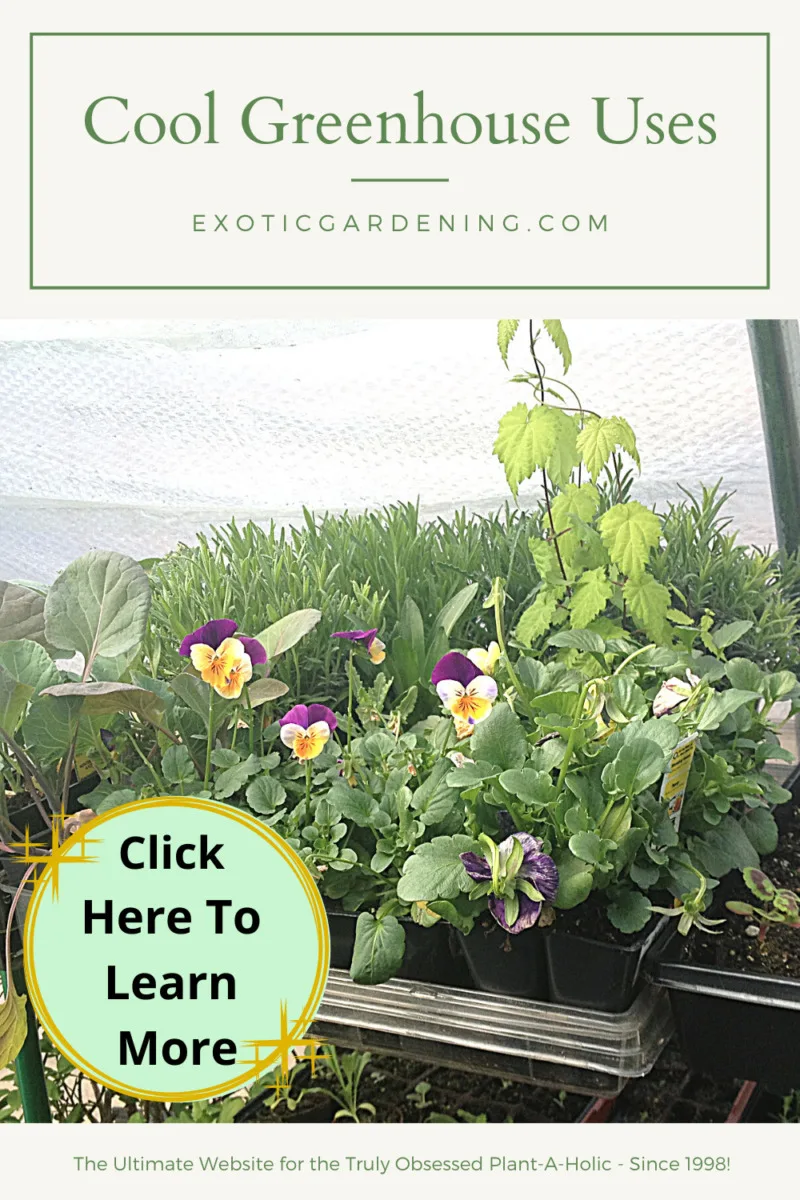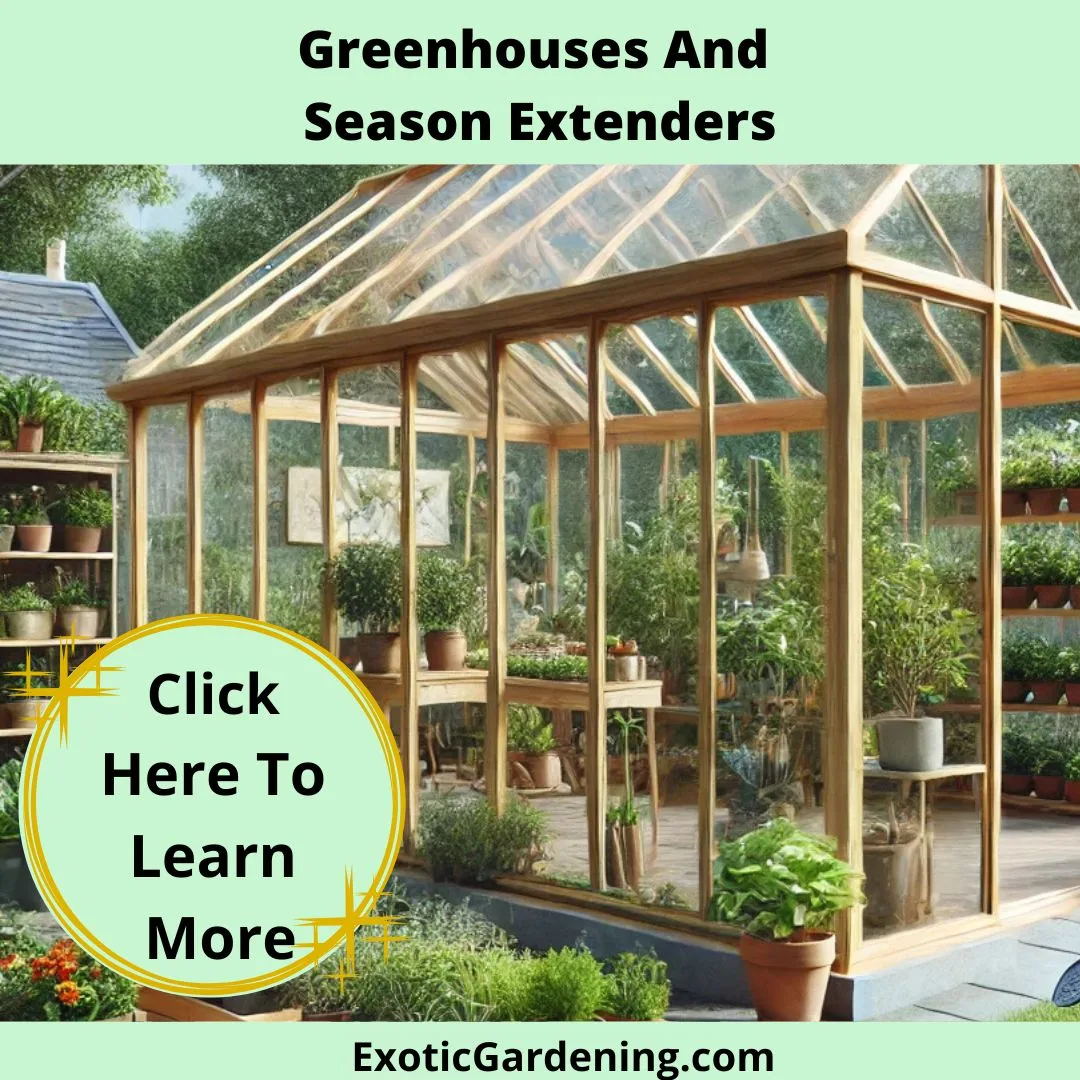If you have an unheated greenhouse, you might wonder what cool greenhouse uses you can come up with to utilize it during the winter season.
Many perennials and cool season vegetables can be started from seed sown in an unheated greenhouse or cold frame, then be transplanted in the open garden once weather permits.
An advantage to this is you will get a head start on the planting season and have flowering plants earlier than if you were to start them outside, the exception being if you use the winter sowing method.
Another way to utilize an unheated greenhouse is to overwinter perennial plants that you didn't get planted in the fall either because they weren't big enough yet, you didn't know where you wanted to plant them or you simply ran out of time.

Cool Greenhouse Ideas
Unheated greenhouses can be a source of real pleasure during the winter months.
They are a great way to provide plant protection from extreme weather conditions.
You can use them to make the most of the midwinter growth lull.
Not to mention you can harvest spring and summer crops up to two months earlier than you could without them.
Think of an unheated greenhouse as a tunnel house - although the structures might be different looking and the intended uses different as well.
Advantages Of A Cool Greenhouse
It is nice to walk into a greenhouse, even if it is unheated in the middle of winter on a sunny day.
The temperatures are sure to be warm enough that you may not need a jacket or coat.
You can sit in the greenhouse and prepare the flats, seed them and water them in comfort.

Ways To Naturally Heat A Cool Greenhouse
If the greenhouse is a bit chilly for you, using a small ceramic heater should warm it up enough to be comfortable while you are working in it.
Rain barrels or other food safe plastic containers can be filled with water and depending on where you live, how warm your greenhouse stays, etc. they may only develop a small sheet of ice on the top of the container which can easily be broken up.
If ice is a real problem, look into an animal water trough heater which could be used to keep the water from freezing.
A well-sealed greenhouse, should however, have plenty of warmth during the day.
It is during the night when the temperatures inside drop drastically.
Besides using rain barrels to try to keep the temperature higher at night in your unheated greenhouse, you could use red bricks to create a floor inside your greenhouse.
During the day, the brick will absorb the heat and just like the rain barrels, release that heat at night.
Using these passive heating methods if you live in a cold climate won't allow you to grow tropical plants over the winter without an additional heat source, but it might raise the temperature just enough to allow you to overwinter things in a dormant stage or get seeds started that you could not have without doing these things.
Don’t forget to add in a few cool weather vegetable crops such as lettuce or kale for your family to eat during the winter.
These crops will do just fine in an unheated structure and it will give you a reason to go into your cool greenhouse during the winter so you can start to learn what the temperature extremes are like.
Other Crops You Can Grow In A Cool Greenhouse Over Winter
Of course, early winter is still a viable growing season in the greenhouse and there are a few crops that will thrive under these conditions, even in the coldest of climates.
Now some of these plants might die out in late December if you do not offer any other form of protection such as frost or row cover or an extra layer of plastic.
Here are a few good crops to grow:
- Arugula
- Broccoli
- Kale
- Onion family members
- Radicchio
- Scallions
- Beets
- Garlic
- Lettuce
- Perennial herbs
- Radishes
- Spinach
My recommendation is to harvest most of these plants by mid to late December.
You can leave a few in the ground if you want just to see what happens.
There is a good chance they will continue to thrive especially if the temperatures do not get extremely cold.
If they do die, you know how to plan for next year and at least you haven't lost your entire crop.
Cool Greenhouse F.A.Q.
Q: What else can you use a greenhouse for other than gardening?
A: Here are a few ideas:
- carving pumpkins
- reading
- any type of outdoor activity when the outdoor weather isn't cooperating
- a warm outdoor retreat in winter
- glamping
- wellness space for yoga or meditation
- hobby studio
- outdoor entertainment area
Q: What do you do with a greenhouse in summer?
A: Use it for heat loving tropical plants or vegetable plants such as tomatoes or peppers. Or you can choose to use a fan or a mister of some type to keep it cool and use it as you normally would.
Q: Should a greenhouse be green or clear?
A: The covering on a greenhouse should be clear, transparent glass or plastic. With that said, the green plastic you see on many greenhouses is ok to use for plants that need shade.
Q: Should a greenhouse be in full sun?
A: Ideally yes, but as long as it received at least 6 hours of direct sunlight during the day, especially in the winter, it should be ok.
Q: How much warmer is a cold greenhouse?
A: A completely unheated greenhouse on a cold night is around 8 degrees Fahrenheit warmer than the outside temperature. However with this said, it is possible for it to be as much as 30 or 35 degrees warmer. The reason this answer varies is it depends on what the greenhouse is made of, how many layers of plastic is being used and if there is a squirrel fan being used to inflate the layers of plastic. Also, passive heat can make a difference. So the best way to know if to pay attention to your own cold greenhouse and keep a log of the temperatures over the course of several years so you can compare them.
Greenhouses And Grow Lights
Dive into a collection of insightful articles designed to help you make the most of your greenhouse and grow light setup. Whether you’re a seasoned gardener or just starting, these blog posts cover everything you need to know to optimize plant growth year-round. From tips on maintaining your greenhouse to choosing the best grow lights for specific crops, this comprehensive list has something for everyone.
Learn about:
Seasonal greenhouse gardening techniques to keep your plants thriving, even in winter.
How to select, set up, and use grow lights effectively for indoor or greenhouse gardening.
Troubleshooting common greenhouse and lighting challenges, like temperature control and light intensity.
DIY projects and budget-friendly ideas to enhance your growing space.
Whether you’re growing food, flowers, or foliage, this collection of articles will inspire and empower you to create a productive and thriving growing environment. Let these resources guide you on your gardening journey!
5 Factors to Consider When Choosing Greenhouse Lighting
There are five factors that are important to consider when choosing greenhouse lighting. Learn what they are and why they are important.
Rare Tropical Plants in Greenhouse #1
Sometimes it's fun to share information on the plants you are growing, especially the rare tropical plants with others.
How To Utilize An Unheated Greenhouse
An unheated greenhouse is easy enough to utilize for a winter vegetable garden or even for winter seed starting.
Top 10 Tips for Making the Most of Your Unheated Greenhouse All Year Round
Discover how to make the most of your unheated greenhouse with these 10 tips for year-round gardening success.
How to Keep Your Unheated Greenhouse Productive: Winter Greenhouse Gardening Tips
Learn winter greenhouse gardening tips to keep your unheated greenhouse productive with crops, insulation, and microclimate tricks.
Dream Big: Revolutionize Your Garden with Year-Round Gardening in an Unheated Greenhouse
Discover the benefits and techniques of Year-Round Gardening in an Unheated Greenhouse for fresh, sustainable, and thriving winter crops.
Feeling Overwhelmed? Unheated Greenhouse Growing Made Simple for Beginners
Unheated greenhouse growing is simple and rewarding. Start small, experiment, and enjoy fresh winter harvests with these easy tips!
Preparing The Greenhouse For Winter
Learn about heating greenhouses in winter and preparing the greenhouse for winter so it is ready for winter greenhouse gardening.
Greenhouse And Cold Frame Garden Structure Ideas
Learn about tunnel houses, greenhouses and cold frame garden structures as well as how they are used to grow plants outdoors year round.
How To Garden In Winter Indoors And Outdoors
Learn how to garden in winter indoors and outdoors. There are many vegetables and herbs that don't mind the cold or thrive in containers.
Greenhouses And Season Extenders
Learn how greenhouses and season extenders help you grow fresh, healthy produce year-round, even in cold climates.
Just One More Greenhouse - Please
One more greenhouse means endless gardening possibilities! Discover tips and inspiration to expand your growing space effectively.
Rebuilding Beauty: My Tropical Greenhouse September 2011
Explore my tropical greenhouse September 2011 journey, showcasing rare plants, restoration efforts, and inspiring gardening tips.
Garden #9 - The Greenhouse Garden
The greenhouse garden area consists of a large greenhouse that is divided into several sections.
These sections operate year-round and house a wide array of tropical plants.














